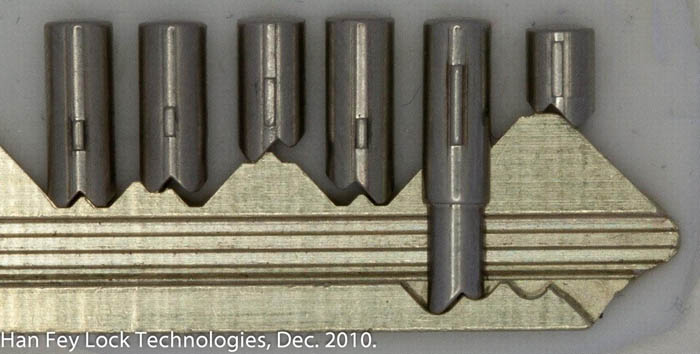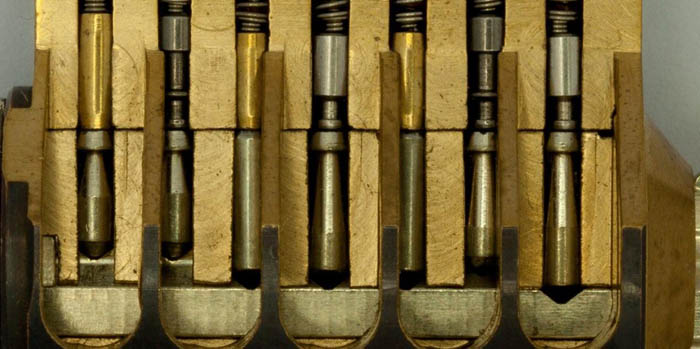Really, I think highly of you. And Han and I are just curious if people know the relationship between these two locks shown below, and how long it will take before the correct answer is given in the comments. After Christmas I will come back with the answer here anyway.
-
Recent Posts
Categories
Meta
Tags
Toool's Blackbag is proudly powered by
WordPress and theme designed by Lavinya
Entries (RSS)
and Comments (RSS).
41 queries. 0.118 seconds.



They can be opened by more than one key. The top one has multiple points where a key could move a pin, the bottom has “pin extender” that allow a lock to turn at multiple key points. Sorry if I create a term. 🙂
They would both be at the sheerline
I noticed the master keying capability of the top lock (I’ve never seen this lock system before), but I’m not seeing the master keying bits in the lower lock described by Benjamin, I’m probably mistaken though. Pins in both pictures appear to be manufactured at high tolerances, but otherwise have no other similarities in technologies that I can tell. Top lock requires pins to have limited or no rotation and probably has patent protection based on the unique pin head shapes used. The bottom lock doesn’t have a sidebar or anything patentable other than the keyway shape, pin rotation does not matter. Otherwise, the bottom lock appears to be a nice cutaway from Frenchconnection/Snowyboy, I’m guessing DOM based on pin shapes. About all I can see they have in common is that they are both pin tumbler based.
I noticed the master keying capability of the top lock (I\’ve never seen this lock system before), but I\’m not seeing the master keying bits in the lower lock described by Benjamin, I\’m probably mistaken though. Pins in both pictures appear to be manufactured at high tolerances, but otherwise have no other similarities in technologies that I can tell. Top lock requires pins to have limited or no rotation and probably has patent protection based on the unique pin head shapes used. The bottom lock doesn\’t have a sidebar or anything patentable other than the keyway shape, pin rotation does not matter. Otherwise, the bottom lock appears to be a nice cutaway from Frenchconnection/Snowyboy, I\’m guessing DOM based on pin shapes. About all I can see they have in common is that they are both pin tumbler based.
The Top one looks like some variant of Medeco, with 2nd cut, the botom one looks like a 7-pin ASSA (pin shapes and stuff). So – both are from one of the numerous brands of Assa Abloy, both probably pickable (but definitively not easily so), and both in Han Fey’s collection? 🙂
Hi Nathan, Let’s correct one thing. The cutaway on the bottom is made by Julian Hardt. It is one of my nicest handmade cutaways. If you look clearly you can see that he really went on the edge with this cutaway, because all the pins / parts are more then clearly to see. You even can see how the bottom pins precisely engage in the cuts of the key.
They are both designed by the same person?
Hello
The top lock is the key to the new “standard” profile of Assa abloy companies like ASSA, Trioving and others. This actual key is a restrictet key in this new series. You can see this at the two cuts in the botom front of the key. The non restricted dont have these cuts.
In this new system each pin can have two hights. and you rotate them in the plug when you build the lock to set the right combination. A narrow keyway, these special pins and “hanging” pins are all features to prevent picking and bumping.
I would guess both are assa locks, The old and the new “standard” key and lock.
I recon the bottom one is an ASSA 7-pin, the top probably the new ASSA d12…
Perhaps I’m being too obvious, but I see a couple of similarities. Both have bitting in two separate parallel planes. and would be dreadful to pick.
I don’t think the top one would open, the rightmost pin’s doesn’t look like it will engage the sidebar. Am I missing something?
I like the top one where the pins have a centering groove that could be very easily found with a hook pick. Sorta like the idea of having a dimple in the pick tip, but this should work better, you could very easily feel that you are on a pin and not some other crevace inside the lock, because the pin would wobble and you would still have it under control with that hook point in that dimple on the pick tip.
it looks like it would work in something like the offset axis of the medeco bi centric lock.
the features on the upper pins are inlets for sidebar fingers and there may also be some rotation stopping outie points as well.
These pins do not rotate like the medeco .
The manufacturer? I think both are ASSA.
Both are bump proof…
Hi readers of Blackbag,
Because I was not totally familiar with the system when I took the pictures, I made a mistake in the picture on top.
People with an eye for detail will see that mistake. Curious how long it will take before other people will see that mistake.
In the article will be clearly explained this error.
Han Fey
Both were designed by Bo Widen.
looks like key pin no. 6 (at the tip of the key) is wrong?
Yep, quick respons by the way. In Barry’s next posting he will show the cylinder with the pins correctly positioned.
[…] my previous posting I asked what two locks had in common. I will now give you the answer. The bottom lock is the famous ‘seven pin’ ASSA 700 […]